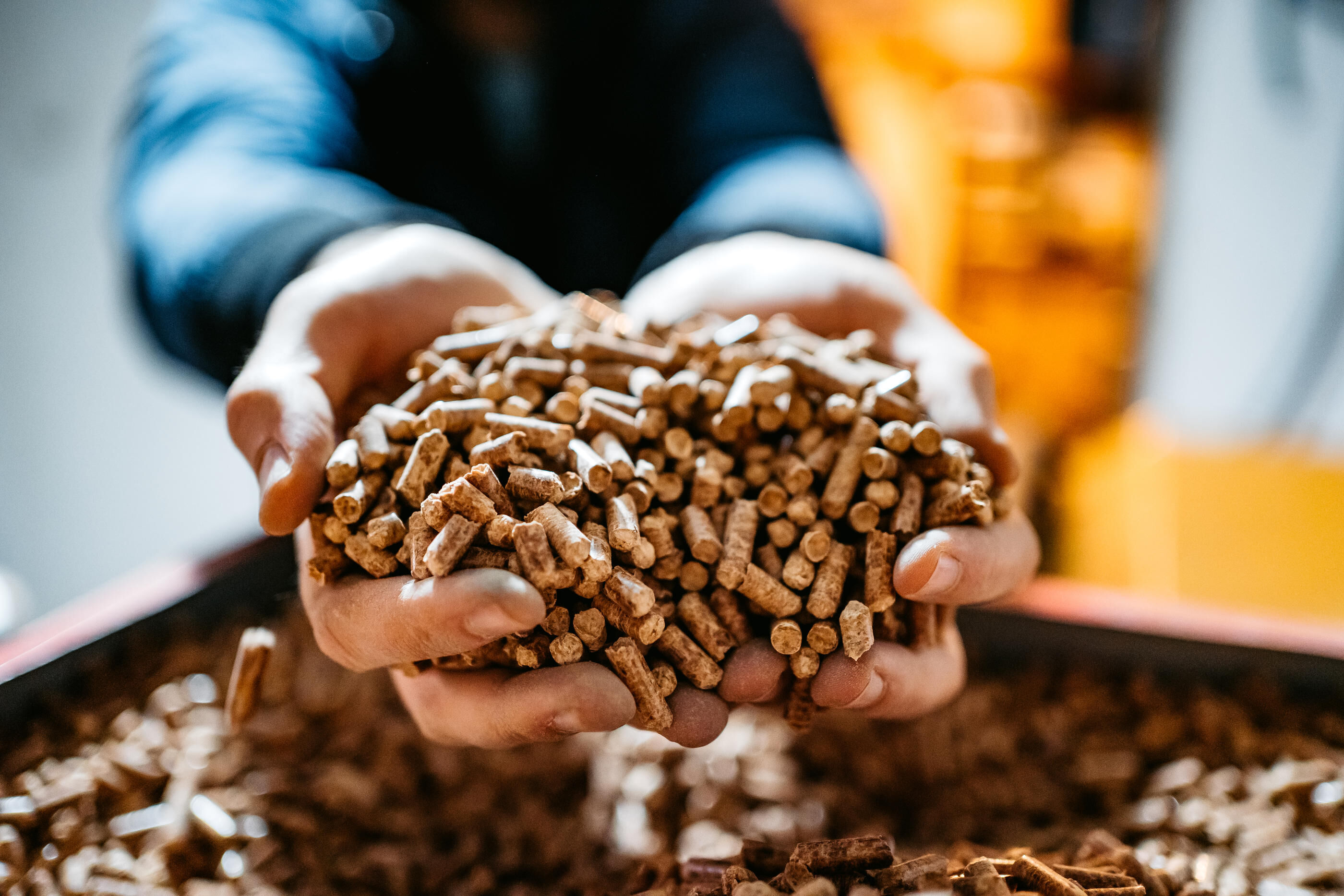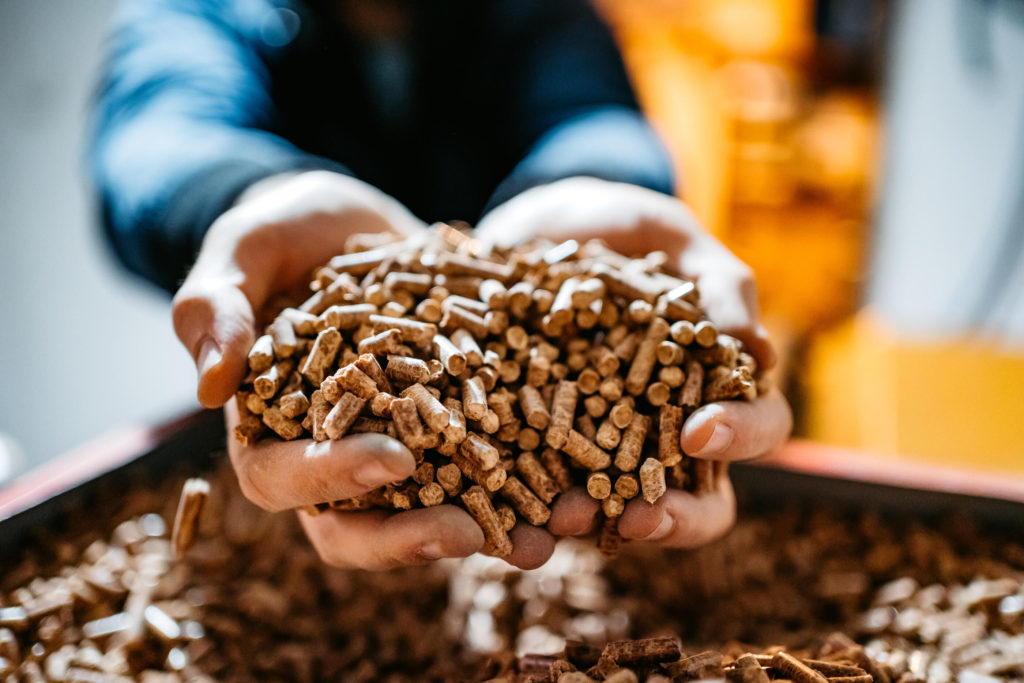
When most people hear the word ‘fuel’, they often associate it with negative connotations due to the impact heating most fuels has on the environment. This is predominantly the case with fossil fuels, however there is a more environmentally friendly alternative. Biomass.
If you’ve never heard of biomass or aren’t completely sure what it is, then stick around to find out more, as we go on to explain what it is, how it can be used for numerous purposes and the benefits of using it.
What is Biomass?
So, what actually is biomass? On a lexical level, it literally translates to ‘living matter’ or ‘matter relating to life’; what this means is that it is material that derives from living organisms, such as plants and animals.
It is typically referred to as a type of energy source, since it can be burned to create heat or converted into other types of fuel.
Wood is typically the most common biomass material used for burning, usually in the form of pellets or chips, since these burn more easily and efficiently and offer a more controlled way of measuring how much you need to burn.
Other biomass materials that could also be used include (but aren’t limited to):
- Organic waste from industries and households
- Agricultural residues (e.g. straw, husks)
- Forestry residues (e.g. branches, foliage, pulp)
- Animal waste
How is Biomass Turned into Energy?
Before biomass is burned, it must first be dried. This is a process that’s known as torrefaction, in which it is heated to 200-320℃. By drying it out completely in this way, it will then lose its ability to retain any moisture, meaning it will no longer be able to rot and can instead be stored for longer periods of time to be used as a heat and energy source.
Naturally, when biomass is burned (as when anything is burned) it gives off heat. However, firing biomass can also generate electricity through the production of steam that is then used to power a generator.
Biomass may also be heated in a different way, through a process called pyrolysis. This involves heating it without oxygen so as to alter its chemistry, which results in a type of gas (syngas), pyrolysis oil (biocrude) and a solid residue (biochar) – all of which can also be used for energy.
The Different Ways to Use Biomass
Heating Your Home
One of the most common ways to use biomass is to heat your home and water. The biomass is ignited in a combustion chamber, where the resulting hot gas and air will then travel through a flue to be passed through a heat exchanger, which transfers the heat to the water in the back boiler – ready to be used in the central heating system and/or for hot water.
Some companies offer the installation of biomass boilers as part of their plumbing and heating services for those who wish to be more environmentally friendly and self-sufficient with their heating system, though they are yet to be as common as traditional boilers.
Generate Electricity
As previously mentioned, the combustion of biomass can also be done to create electricity. When burned in a boiler with oxygen, biomass produces a high pressure steam, which then flows over a series of turbine blades. The pressure with which it flows over these blades causes the turbine to rotate, which in turn powers a generator in order to generate electricity.
This electricity can then be used in various applications, such as powering your home, heating a building or used in manufacturing.
Power a Vehicle
As we mentioned, if put through pyrolysis, biomass can create a component called biocrude. This is a type of tar that can be used as biofuel to power vehicles. In comparison to petrol or diesel, biofuel is shown to emit significantly less greenhouse gases, hence why it is most commonly used in transportation.
In addition to this, biocrude can also be combusted as another way of generating electricity. It may also be used as a component in plastics.
The reason it is seen as favourable over traditional crude oils and petroleum is not only down to its lower emissions, but because it can be produced in a short period of time, rather than the slow natural processes that produce fossil fuels.
Advantages & Disadvantages of Biomass Boilers
Pros
Renewable Energy Source
Perhaps the biggest advantage of using biomass is that it is an environmentally friendly, renewable energy source. Unlike fossil fuels, biomass is clean and sustainable, able to be harvested without large negative impacts on the environment.
Energy from fossil fuel sources, such as coal or crude oil, are not considered sustainable due to the length of time it takes for them to re-generate, whereas biomass can be obtained much quicker through the replacement and growth of new plants and trees.
Furthermore, these will even offset carbon emissions if farmed and replaced sustainably; they will assist in the exchange of carbon in the carbon cycle, reabsorbing the carbon in the atmosphere released by the burning of other biomasses through the process of photosynthesis, using this to help its growth before being used itself as a biomass at the end of its lifespan.
Not only that, but whilst the burning of biomass does still release carbon dioxide into the atmosphere, the levels that are released are significantly less than that of fossil fuels and other non-renewable energy sources. Replacing your electric heating system, then, with a biomass boiler could help to reduce your annual carbon dioxide output by up to 9.5 tonnes.
Waste Disposal
Another environmental benefit of biomass is that it is a great way for you to manage and dispose of biological waste, whilst benefiting from the energy it provides.
Rather than harvesting wood exclusively for burning, using natural plant and wood waste where possible makes the process even more sustainable. Furthermore, you will then be managing areas that would otherwise be unsightly and saving yourself money by using your own organic wood waste that you otherwise would have no use for.
Affordable
If you are a homeowner and/or drive a vehicle, then you will be aware of the surge in prices for electricity and fuel that the UK has faced over the previous year. Despite people already facing steeply increasing bills in the current cost of living crisis, it is expected that these prices will continue to steadily rise.
Investing in a biomass boiler to replace your electric heating system will see these bills reduced again. The price of biomass needed for these boilers (such as wood pellets) is much cheaper than electric heating, whilst remaining consistently stable – making it less likely, if not almost completely unlikely that you will see your bills double in a matter of months due to surging energy prices!
Cons
Size
Compared to traditional modern boilers, biomass boilers take up more space since they use a larger system in order to operate. Assuming you have the space, then this shouldn’t be an issue, but it is worth considering if you haven’t thought about where you’d plan to put a biomass boiler.
In addition to this, you will also need somewhere dry to store your supply of wood pellets for when the boiler needs replenishing, which brings us onto our next disadvantage.
Maintenance
One of the main downsides to biomass boilers is that they require regular maintenance and actively need to be replenished with wood pellets. Typically, a biomass boiler requires refuelling every 3-4 days, although some come with auto-feed hoppers (which stores pellets and feeds them into the boiler when needed) and will only need refuelling every 2-3 weeks.
In addition to having to feed the boiler, it will also require regular cleaning (about once a week) in order to remove the ash that is left behind as a result of the wood being burned. However, some modern biomass boilers do incorporate a feature that makes this very simple and easy to do or even have an automatic feature that does it for you.
Initial Cost
Whilst biomass boilers are more affordable to run compared to the boilers, they simultaneously have the drawback of being a high initial investment.
Installing a biomass boiler in your home will set you back anywhere between £4,000 – £8,000. There used to be a government scheme known as the Domestic Renewable Heat Incentive scheme (DRHI) that biomass boilers would qualify for, in which you would receive periodical payments over several years, which would then help towards offsetting the initial investment, however this is no longer available for new applicants.
Ian Hobbs Technical Services
Are you looking to be more sustainable and self-sufficient with the energy usage in your home? Then you may consider investing in a biomass boiler. Providing services across the South West, Ian Hobbs is able to provide and install biomass biomass boilers for you.
As well as plumbing and heating services, we also offer a range of other technical services, including refrigeration maintenance and aircon installation.
For expert advice and guidance, or for your free no obligation quote, contact us today and a member of our team will be happy to help.

 01761 414 356
01761 414 356



